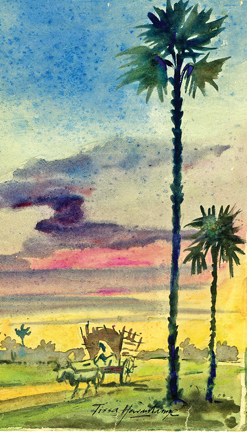How to paint the sky better
by Tissa Hewavitarane
The laws of perspective apply to the sky just as they do to the land.
Yet, so many perfectly good landscape paintings are ruined by a sky that
looks like a limp curtain hanging at the back of the scene.
When painting a sunny day many beginners underestimate the often very
strong contracts of light and shadow that occur. When painting a scene
bathed in bright sunshine remember that either the bright warm areas
should dominate or the cool dark shadow areas.
If there is an even spread of lights and darks, the effect of bright
sunshine will be lost. Shadows may sound like a contradiction, but they
play an important role in conveying an impression of bright sunlight.
Everything the sun hits becomes warmer and more intense in colour
whereas objects in shadow are correspondingly cool. Adjacent warm and
cool colours have the effect of intensifying each other and this creates
a luminous glow that spells sunshine. Remember in mixing your colours,
do not just think "green", it's that warm green or a cool green that
weaves a pattern of warm and cool colour throughout the composition.
|

The formation of clouds |
On a sunny day there's a lot of ultraviolet light around and blue
violet light rays are often reflected in the shadows.
Decision
Certain decisions have to be made even before you start to paint. For
example what kind of day is it? Where is the sun? Over there, many
students say, running their hand across the left side of their paper.
They do not realise that you have to pinpoint the sun in the sky. Is it
to the left or right? Is it high or low?
In front of you or behind you?
Each shift in position changes the character of the subject. That's
why watercolourist learn to work quickly outdoors. The light determines
the quality of the edges, the vibrancy of the colour and the contrast
between values (the key of the picture).
You have to determine your theme, the kind of mass and line that
corresponds to the theme and even the paper that best fits the
particular subject. The danger in watercolour is when you only half-know
and then try to correct while you paint. Know first and the medium will
work for you.
When I start painting, my real subject is the quiet mood of the day.
I paint what I feel not just what I see. I first paint the warm
sky,preparing the area by wetting it. The wet paper gives a better
control of the wash. The sky colour reflects down on the upright planes.
This makes more sense. I believe in the old watercolour practice of
unifying a picture by throwing a lot of earth colour into the heavens.
Blue skies
The whole sky should be planned beforehand. What sort of weather
condition you are going to have whether it's a windy, stormy or clear
blue sky. The worst thing you can do is to paint some water tones over
the area and drop some darks in trusting to fate and luck that they will
look like some sort of clouds and fool somebody.
In general painting skies is rather like going off a high diving
board. It looks scary before you do it.
Here are a few basic facts about skies which will make them look
convincing.
Essential features
First clear blue skies should never be flat but are darker above and
lighter as they approach the horizon. It's important to realise that
clouds have their own perspective too, in as much as the big ones are
always at the top of the picture and they gradually get smaller and
weaker as the approach the horizon. Going back to the high diving board,
the more you practise the more confident you'll become.
Try doing at least one sky every day. You do not need to do the whole
picture, just look out of the window any day of the year and work out
quietly in your mind. Then you get the brush in your hand and decide
what sequence of washes you're going to use. Select the essential
features and simplify by using the big brush only and working quickly
and decisively.
You can even give your self a time limit of say ten minutes. You'll
be amazed how quickly you'll be working with increased authority and
pleasure.
Another simple rule to remember is that if you have a complicated
landscape give it a simple sky, but if you want to paint an elaborate
sky, set it against a relatively simple landscape.
There are three main families of clouds cirrus, a thin wispy high
cloud, cumulus, a white, wooly type which has a light top where the sun
catches it, with a shadow undernathe. The third type is nimbus, which is
a rain cloud and usually means business.
Of course, in reality, things are more complex. And you get the
variety types of overlapping. A plain layer of low cloud is called
stratus.
Shadow areas
Skies can be soft or crisp, light or dark, designed or appear
natural. Clearly skies are made with graded washes (dark above light
below) and should never be flat looking, because the sky is not flat.
Clouds on dry paper should be drawn lightly with pencil (if that is
necessary) and the darkest blue or grey-blue brushed in around the
clouds.
The grey or yellow-grey of the clouds in brushed in the shadow areas
and left alone.
Keep the values light unless a dramatic effect is needed. You can put
the sky in first or leave it till later. Artists use both methods.
Clouds and skies are constantly changing.
They can be manipulated by the artist to satisfy the requirements of
each painting. The painting reproduced here depicts the formation of
clouds on a wet background capturing the fusion of tones to achieve the
desired effects. |

